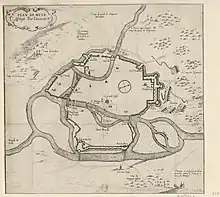| Siege of Metz | |||||||
|---|---|---|---|---|---|---|---|
| Part of the Habsburg-Valois War | |||||||
 Map of Metz during the siege | |||||||
| |||||||
| Belligerents | |||||||
|
|
| ||||||
| Commanders and leaders | |||||||
|
|
| ||||||
| Strength | |||||||
| 6,000[1][3] | |||||||
| Casualties and losses | |||||||
| 20,000[1]-30,000[3] | Unknown | ||||||
The siege of Metz during the Italian War of 1551–59 lasted from October 1552 to January (1-5), 1553.
The so-called Augsburg Interim came to an end when Protestant princes of the Schmalkaldic League approached Henry II of France and concluded the Treaty of Chambord, giving the free cities of Toul, Verdun, and Metz (the 'Three Bishoprics') to the Kingdom of France. The Holy Roman Emperor Charles V[2] laid siege to the French garrison commanded by Francis, Duke of Guise.[1] Although cannonades destroyed large parts of the fortifications (see fr:Remparts médiévaux de Metz), the Imperial army was unable to take the city. Stricken by typhus, dysentery, and scurvy,[1] Charles' army was forced to abandon the siege along with the sick and wounded. Metz remained a French protectorate (fr:République messine) until its annexation was formalized in 1648 by the Treaty of Westphalia.[4]
References
- 1 2 3 4 5 Gabriel 2013, p. 59.
- 1 2 Parker 1976, p. 207.
- 1 2 3 4 René Bour, Histoire illustrée de Metz, Paul Even, Metz, 1950 (p.125-129).
- ↑ Chaunu 2000, p. 707-760.
References
- Chaunu, Pierre (2000). L'Espagne de Charles Quint. Eds. Fayard.
- Gabriel, Richard A. (2013). Between Flesh and Steel: A History of Military Medicine from the Middle Ages. Potomac Publishers.
- Parker, Geoffrey (1976). "The "Military Revolution," 1560-1660--a Myth?". The Journal of Modern History. The Chicago University Press. 48 June (2): 196–214. doi:10.1086/241429. S2CID 143661971.